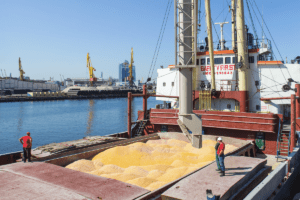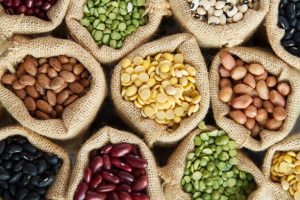
The Ukrainian Grain Association (UGA) has asked the government to organize a grain corridor for transporting grain to the Danube river ports through the border crossing near the village of Palanca (Moldova), the road to which was not previously used for agricultural exports.
The UGA proposed the corresponding route as an alternative to the railway bridge across the Bilhorod-Dnistrovsky estuary, which was damaged due to repeated shelling by Russians and now does not function, according to the association’s website.
The UGA recalled that before the Russian invasion, Ukraine exported 95-98% of agricultural products through seaports, in natural terms – 5-6 million tonnes per month. However, after the blockade of the Black Sea seaports, Ukraine can transport no more than 1.5 million tonnes per month by alternative routes.
“Currently, most of the grain exports are carried out through the Ukrainian ports of the Danube. Unfortunately, one of the ways to access the Danube ports is the bridge over the Bilhorod-Dnistrovsky estuary, which is damaged, and now the movement of rail cars and road transport is very difficult. An alternative way to access the Danube ports is the road through the village of Palanca (Moldova),” the UGA points out.
Meanwhile, the road to Palanca was not previously used for the transport of commercial goods, so its capacity is significantly limited.
Given the above and the current state of affairs in Ukraine, the UGA asks the government to create a “green corridor” for the transportation of grain cargo for export through the Danube ports, in particular in the area near the village of Palanca.
The Ukrainian Grain Association is an association of producers, processors and large grain exporters who annually export about 90% of Ukrainian grain products.

The Ukrainian Grain Association (UGA) estimates the export volumes of grains (wheat, corn and barley) by Ukraine in the 2021/2022 marketing year (MY, July-June) at 57.5 million tonnes, which is 28.8% higher than the results of 2020/2021 MY, the press service of the Ukrainian Grain Association (UGA) told Interfax-Ukraine on Tuesday.
“According to our preliminary estimates, more optimistic than the ministry’s, the export of grains (wheat, corn and barley) this season may reach 57.5 million tonnes with a harvest of 74.5 million tonnes,” the press service of the UGA organization clarified, commenting on the forecast of the Ministry of Agrarian Policy, according to which in 2021/2022MY the export of these crops can reach 56 million tonnes with a harvest of 75.8 million tonnes.
The Association also provided for comparison the data of the International Grains Council (IGC), in the latest report of which the export of grain from Ukraine in the current MY is projected at 55.4 million tonnes with a harvest of 76.2 million tonnes.
The press service of the organization of grain traders clarified that the total export of grain crops together with oilseeds in 2021/2022 MY may exceed 62 million tonnes with a gross harvest of more than 100 million tonnes.
UGA also commented on the signing of a Memorandum of Understanding for 2021/2022 MY between the participants of the grain market and the Ministry of Agrarian Policy and Food on July 5. According to its press service, an annex to the memorandum, which specifies the maximum export volumes of agricultural products, will be signed after the volumes of the harvested crop become known.
“The relevant ministry and the participants of the grain market traditionally sign a Memorandum with the beginning of a new grain season. The maximum export volumes are agreed upon later, when the indicators of the harvested crop of a particular crop are already known,” the press service of UGA noted.

Exports ofgrains and oilseeds in the 2020/2021 marketing year (MY, September-August) will amount to 46.8 million tonnes, which is a quarter less than in the record 2019/2020 MY.
According to the website of the Ukrainian Grain Association (UGA), citing data from grain traders, the maximum export volume of these crops in the current season will not exceed the values specified in the annexes to the memorandum between the Ministry of Economic Development, Trade and Agriculture and market participants.
The UGA clarified that the rate of grain export in the current MY is significantly lower than last year’s indicators, which is due to the conjuncture of world markets.
The association expects that wheat exports in the current season will not exceed 16 million tonnes, which is significantly lower than the volume specified in the appendix to the memorandum of 17.5 million tonnes. Corn exports in the current season will not exceed 22 million tonnes, which is also below the limit set in the annex to the memorandum – 24 million tonnes.
As reported, Ukraine exported 37.71 million tonnes ofgrains and legumes since the beginning of 2020/2021 MY, which is 23.6% less than on the same date of the previous MY.
According to the information and analytical portal of the agro-industrial complex of Ukraine, to date, 14.78 million tonnes of wheat, 18.19 million tonnes of corn, 4.12 million tonnes of barley and 102,200 tonnes of flour have been exported.

The Ukrainian Grain Association (UGA) has agreed to limit the export of corn in the 2020/2021 MY to 24 million tonnes by the end of June in the grain memorandum, since given the association’s export forecasts and the practice of such memorandums, the practical implementation of such a limitation is unlikely.
“The introduction of the maximum corn export volume in the memorandum between the Ministry of Economy and business associations representing participants in the grain market is rather a symbolic step to ensure predictability and tranquility in the grain market,” the UGA said on its website.
The association emphasized the absence of grounds for statements about the likelihood of a shortage of corn on the Ukrainian market. According to its estimates and official statistics, with a harvest of this MY of about 30 million tonnes and internal needs of about 5 million tonnes, exports by mid-January amounted to about 10 million tonnes, of which 2 million tonnes was corn from the previous MY. The UGA also recalled that this year corn exports in mid-January lagged behind last year by almost 3.5 million tonnes.
The association predicts that in the future the rate of export will decrease, as Ukraine has already passed the peak period of export of this crop. The UGA also believes that high prices for corn and benchmarks for its export will give producers a positive signal to expand the area under this crop in 2021.
In addition, the UGA notes that for all the years of the memorandums and the similar restrictions contained in them with respect to wheat, they have never been applied in practice.

Unscrupulous agricultural producers, amid a low harvest, are trying to disrupt the previously concluded forward contracts for the supply of grain, which could collapse the grain market of Ukraine and provoke disastrous results both for the agricultural sector and for the country’s economy as a whole already in the current marketing year, Ukrainian Grain Association (UGA) President Mykola Horbachev believes.
“Today, many unscrupulous producers, seeing an increase of market prices, want to refuse to fulfill the previously concluded contracts, in fact to make a default. And we are not talking about those agrarians who lost crops due to drought or other weather disasters, but those who had good harvest,” he explained in an exclusive commentary to the Interfax-Ukraine agency.
Because of this, Ukraine may lose a source of about $11-12 billion to finance the agricultural sector, he said.
Horbachev also said that companies that did not suffer from drought in some regions of the country are trying not to fulfill the previously signed contracts for the supply of grain, aiming to get excess profits at the expense of counterparties. Such unfair actions will inevitably lead to both economic and reputational losses for the entire economy of the country.
According to the UGA assessment, in the spring, the agrarians contracted about 6 million tonnes of maize of the current harvest on forward contracts at a price of $150-160 per tonne, thus receiving financing for the sowing campaign.